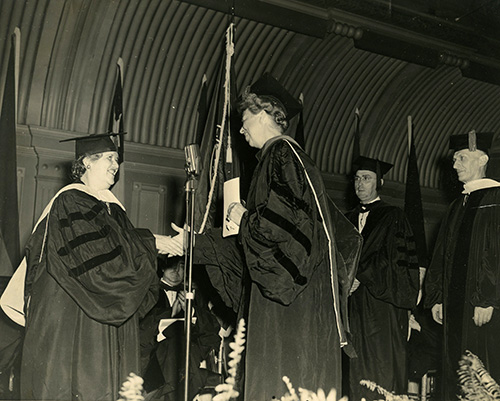Esther Neira de Calvo (1890-1978) was a prominent Panamanian educator, women’s rights advocate, politician, and diplomat. The extensive Esther Neira de Calvo papers, housed here at the Booth Family Center for Special Collections, document her extensive work as an advocate for women’s rights as well as her interactions with leading American women’s rights crusaders, including Carrie Chapman Catt and Eleanor Roosevelt.
Esther Neira de Calvo was born in Panama and studied at the Institut Pedagogique de Wavre-Notre Dame in Belgium, College of Mount St. Vincent, and Columbia University in New York. During her career in Panama, she served as Inspector General of Education (1923-1927), director of Panama’s Normal School for Women (1927-1938), and head of the Lyceum, a university preparatory school for women (1938-1945). In her native country, she also founded the National Society for the Advancement of Women (1923) and the Women’s Patriotic League (1945). As an elected delegate in 1945 to the Third Constituent Assembly, she contributed to the drafting of a new national Panamanian constitution, which was enacted in 1946. She moved to Washington, D.C. to serve as Executive Secretary of the Inter-American Commission of Women of the Organization of American States (OAS) from 1949 to 1965. The following year, the government of Panama appointed her Ambassador, Alternative Representative to the OAS. She held that position from 1966 to 1968.
Carrie Chapman Catt (1859-1947) was an important leader in the American women’s rights movement. In 1900, she replaced Susan B. Anthony as president of the National American Woman Suffrage Association. Owing to her efforts and those of her fellow suffragettes, the U.S. Congress passed the 19th Amendment in 1920 granting American women the right to vote in political elections. Moreover, Catt was instrumental in the creation of the League of Women Voters. After World War I, Catt participated in the peace movement.

The Esther Neira de Calvo papers contain a photograph depicting both Catt and Neira de Calvo in Panama (box 6a, folder 23). In the image, dated Tuesday, March 13, 1923, Catt stands at a podium addressing the crowd at a conference at the National Institute in Panama. Catt spoke about feminism in her address titled “For the Women of Panama.” This speech was a follow-up to the Pan-American Conference of Women held in Baltimore in April 1922, which Neira de Calvo had attended as a delegate of Panama. In the photograph, Neira de Calvo, the President of the National Society for the Progress of Women, is seated to Catt’s right at the head table. Christine Bradley South, the wife of the U.S. Minister to Panama, is seated to Catt’s left. The man at the head table is most likely Minister South.
Eleanor Roosevelt (1884-1962), the wife of U.S. President Franklin D. Roosevelt, worked actively for equal rights for women throughout her lifetime. She served in the League of Women Voters on the Legislative Affairs Committee. She is also known for her work with the United Nations, and she helped draft the Universal Declaration of Human Rights in 1948. Roosevelt often traveled to visit leaders around the world.

The papers also include a photograph of Neira de Calvo with Eleanor Roosevelt (box 7a, folder 116). In the picture, dated October 10, 1941, Neira de Calvo shakes hands with the First Lady, who awards her an honorary Doctorate of Pedagogy from Russell Sage College in Troy, New York, for her achievements in women’s education. The event took place at an Inter-American convention. At that time, Neira de Calvo was Director of the Women’s Lyceum in Panama and Delegate of Panama to the Inter-American Commission of Women.
As demonstrated by these two photographs, which are 18 years apart, Neira de Calvo’s work on behalf of women’s rights spanned decades. She tirelessly advanced her goals. In the process, she met and cooperated with some of the leading luminaries of women’s rights in the twentieth century.
—Scott S. Taylor, Manuscripts Archivist
January 15, 2019
